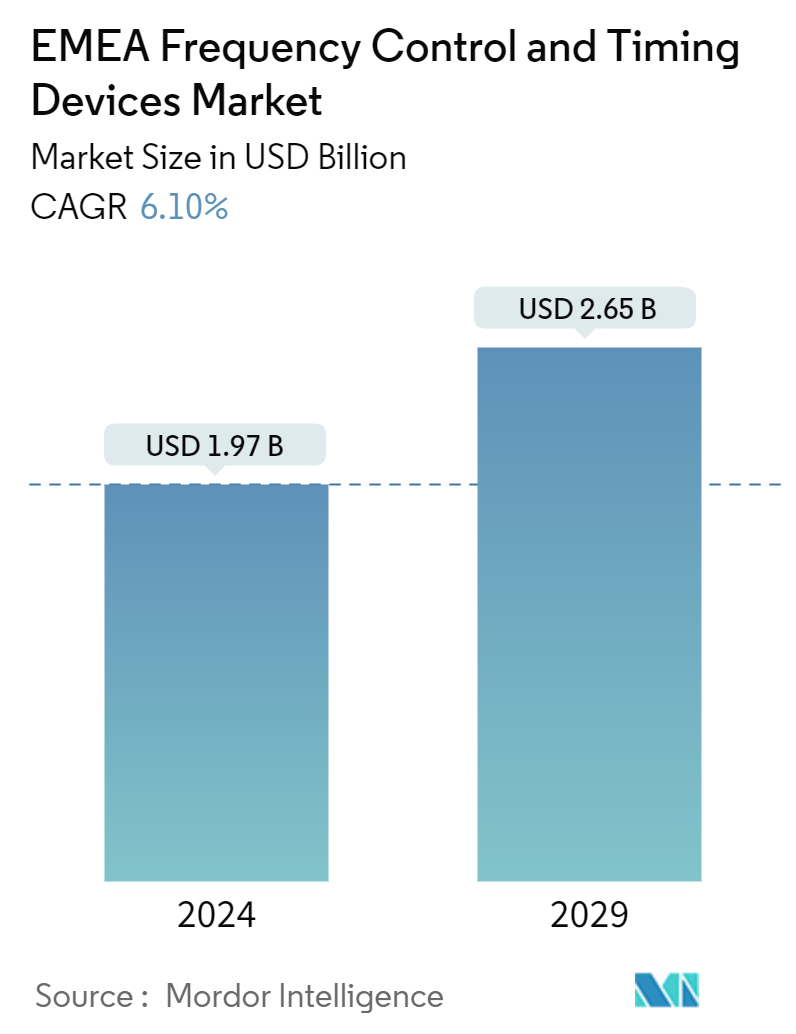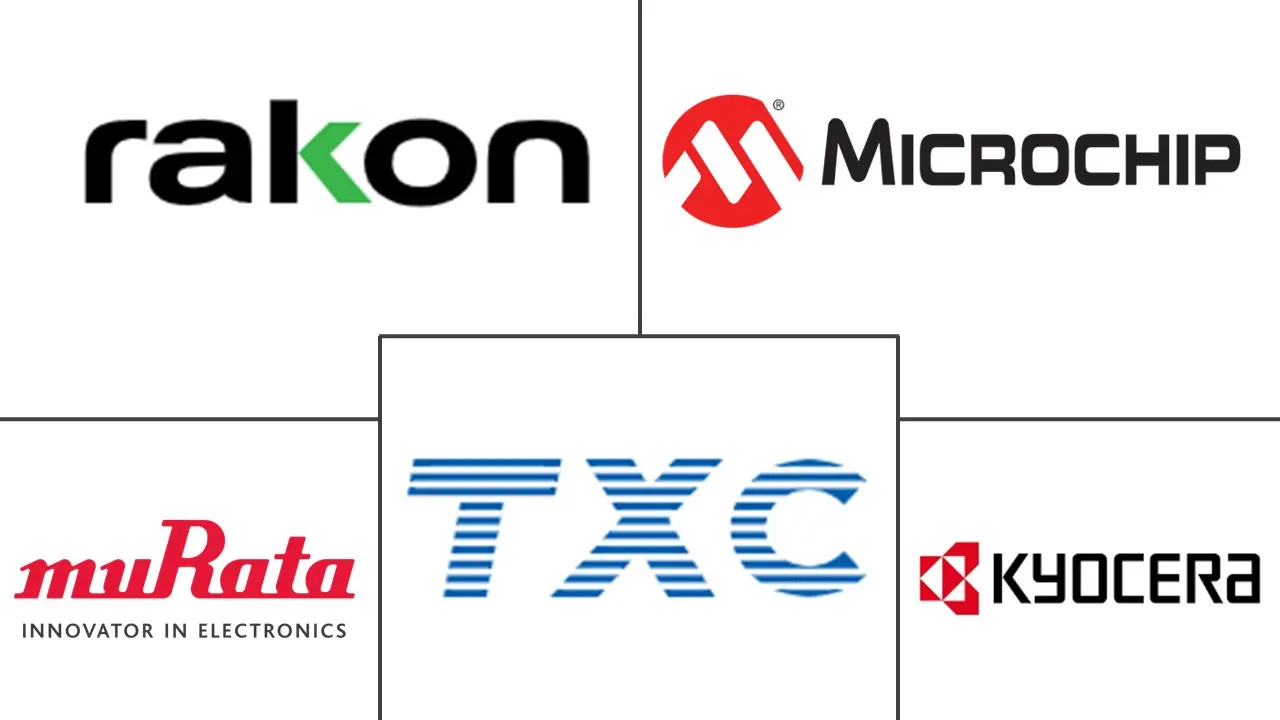Market Size of EMEA Frequency Control And Timing Devices Industry

| Study Period | 2019 - 2029 |
| Base Year For Estimation | 2023 |
| Market Size (2024) | USD 1.97 Billion |
| Market Size (2029) | USD 2.65 Billion |
| CAGR (2024 - 2029) | 6.10 % |
| Market Concentration | Low |
Major Players
*Disclaimer: Major Players sorted in no particular order |
EMEA Frequency Control And Timing Devices Market Analysis
The EMEA Frequency Control And Timing Devices Market size is estimated at USD 1.97 billion in 2024, and is expected to reach USD 2.65 billion by 2029, growing at a CAGR of 6.10% during the forecast period (2024-2029).
The frequency control and timing device market faced significant disruptions due to the Russo-Ukraine conflict and an economic slowdown. Rising inflation and interest rates curtailed consumer spending, dampened semiconductor demand, and slowed the growth of FCTDs. In response to the conflict, Europe has shifted its focus toward the defense and aerospace sectors, leading to heightened demand for these components and opening up new growth avenues.
- The rising adoption of smart home technologies creates a positive outlook for market growth. Smart homes consist of interconnected devices such as smart thermostats, lighting systems, security cameras, and appliances that need to communicate and operate seamlessly together. Frequency control and timing devices ensure the synchronization of these devices, providing accurate timing signals for data transmission, control signals, and event scheduling.
- According to the GSMA report, smartphone adoption in the MENA region is expected to increase from 54% in 2018 to 74% in 2025. By 2025, smartphones will make up 61% of all connections in Sub-Saharan Africa. Noticeably, the number of 5G connections is expected to reach 45 million and 41 million by 2025 in the MENA and Sub-Saharan African regions, respectively.
- Robots use oscillators for synchronized operation and time-sensitive tasks. The utilization of industrial robots in the region has been on the rise in numerous end-users and applications due to their ability to improve precision and adaptability, minimize product damage, enhance speed, and ultimately optimize operational efficiency.
- The rise of advanced automotive applications is a significant driver for the growth of EMEA frequency control and timing devices in the automotive industry. The increasing adoption of ADAS is a substantial contributor to the market growth. These systems rely on real-time sensor data processing for automatic emergency braking, lane departure warning, and adaptive cruise control. Frequency control devices provide the accurate timing for these systems to respond promptly and accurately.
- The frequency control and timing devices market is a critical segment within the electronics industry, providing essential components for various applications. However, the high costs of developing and producing these devices challenge the market's growth.
- Factors like GDP growth, government budget constraints, geopolitical factors, and fiscal policies significantly impact military spending in EMEA. According to NATO, in 2023, Spain's defense expenditure was estimated at USD 19.18 billion, the highest spending since 2014. The expenditure was estimated to be USD 14.90 billion in the previous year. Such figures gave Spain the eighth-highest defense expenditure among NATO members.
EMEA Frequency Control And Timing Devices Industry Segmentation
Frequency control and timing devices (FCTD) are electronic components that generate, control, and synchronize timing signals in various electronic systems. They are crucial in ensuring accurate timing, synchronization, and operations coordination within these systems. Applying the principles of timing devices to quartz crystals, MEMS, and ceramic resonators makes it possible to generate oscillations with stable frequencies. These timing devices help to ensure the precise operation of devices in Zigbee, Bluetooth, and other wireless applications (such as smartphones), automobiles, and medical equipment.
The EMEA frequency control and timing devices market is segmented by type (crystals, oscillators (temperature compensated crystal oscillator (TCXO), voltage-controlled crystal oscillator (VCXO), oven-controlled crystal oscillator (OCXO), MEMS oscillator, and other types of oscillators), resonators, saw filters, and real-time clocks), end-user industry (automotive, computer and peripherals, communications/server/data storage, consumer electronics, industrial, defense and aerospace, IOT, other end-user industries), and country (United Kingdom, Germany, France, Italy, GCC, South Africa, and Rest of EMEA). The report offers the market size in value terms in USD for all the abovementioned segments.
| By Type | |||||||
| Crystals | |||||||
| |||||||
| Resonators | |||||||
| Saw Filters | |||||||
| Real Time Clocks |
| By End-user Industry | |
| Automotive | |
| Computer and Peripherals | |
| Communications/Server/Data Storage | |
| Consumer Electronics | |
| Industrial | |
| Defense and Aerospace | |
| IoT | |
| Other End-user Industries |
| By Country | |
| United Kingdom | |
| Germany | |
| France | |
| Italy | |
| GCC | |
| South Africa |
EMEA Frequency Control And Timing Devices Market Size Summary
The EMEA Frequency Control and Timing Devices Market is poised for growth, driven by the increasing demand for precision timing solutions across various sectors. The market is experiencing a shift due to geopolitical tensions, such as the Russo-Ukraine conflict, which has redirected focus towards defense and aerospace applications, thereby creating new opportunities for frequency control devices. The automotive industry is also a significant contributor to market expansion, with advanced driver-assistance systems (ADAS) and the rise of electric vehicles necessitating accurate timing for enhanced safety and performance. Additionally, the adoption of smart home technologies and the proliferation of industrial automation, particularly in Germany's Industry 4.0 initiatives, are further propelling the demand for these devices. Despite challenges like high development costs, the market is expected to benefit from technological advancements and increasing consumer preferences for connected and intelligent devices.
Key players in the EMEA Frequency Control and Timing Devices Market, such as Murata Manufacturing, Kyocera Corporation, and Rakon Limited, are actively enhancing their product offerings through strategic acquisitions and partnerships. Innovations like KYOCERA AVX's new manufacturing facility for low-noise quartz crystal products and Rakon's advanced IC-OCXO items highlight the industry's focus on developing high-performance solutions for telecommunications and data centers. The market's growth is also supported by collaborations between industry, academia, and research institutions, particularly in Germany, which foster innovation and the development of cutting-edge technologies. As the demand for robust and reliable timing solutions continues to rise, the market is expected to expand, offering lucrative opportunities for suppliers and manufacturers.
EMEA Frequency Control And Timing Devices Market Size - Table of Contents
-
1. MARKET INSIGHTS
-
1.1 Market Overview
-
1.2 Industry Value Chain Analysis
-
1.3 Industry Attractiveness - Porter's Five Forces Analysis
-
1.3.1 Bargaining Power of Suppliers
-
1.3.2 Bargaining Power of Buyers
-
1.3.3 Threat of New Entrants
-
1.3.4 Threat of Substitutes
-
1.3.5 Intensity of Competitive Rivalry
-
-
1.4 Impact of COVID-19 Aftereffects and Macro Economic Trends on the Industry
-
-
2. MARKET SEGMENTATION
-
2.1 By Type
-
2.1.1 Crystals
-
2.1.2 Oscillators
-
2.1.2.1 Temperature Compensated Crystal Oscillator (TCXO)
-
2.1.2.2 Voltage-controlled Crystal Oscillator (VCXO)
-
2.1.2.3 Oven-controlled Crystal Oscillator (OCXO)
-
2.1.2.4 MEMS Oscillator
-
2.1.2.5 Other Types of Oscillators
-
-
2.1.3 Resonators
-
2.1.4 Saw Filters
-
2.1.5 Real Time Clocks
-
-
2.2 By End-user Industry
-
2.2.1 Automotive
-
2.2.2 Computer and Peripherals
-
2.2.3 Communications/Server/Data Storage
-
2.2.4 Consumer Electronics
-
2.2.5 Industrial
-
2.2.6 Defense and Aerospace
-
2.2.7 IoT
-
2.2.8 Other End-user Industries
-
-
2.3 By Country
-
2.3.1 United Kingdom
-
2.3.2 Germany
-
2.3.3 France
-
2.3.4 Italy
-
2.3.5 GCC
-
2.3.6 South Africa
-
-
EMEA Frequency Control And Timing Devices Market Size FAQs
How big is the EMEA Frequency Control And Timing Devices Market?
The EMEA Frequency Control And Timing Devices Market size is expected to reach USD 1.97 billion in 2024 and grow at a CAGR of 6.10% to reach USD 2.65 billion by 2029.
What is the current EMEA Frequency Control And Timing Devices Market size?
In 2024, the EMEA Frequency Control And Timing Devices Market size is expected to reach USD 1.97 billion.

